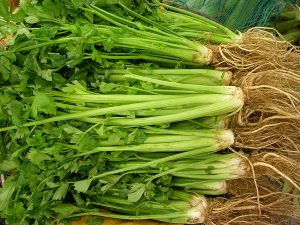Nose-to-tail cookery: it’s the new trend of many well-known chefs that uses all parts of the animal – from the nose to the tail, and yes the parts in between – to create delicious dishes. While this idea may not have mass appeal, it’s a great concept to consider when it comes to your fruits and vegetables.
Have you ever eaten a leaf from a celery stalk or sweet potato plant? Have you thought about the cancer-protective nutrients that could be hidden in those scrawny looking leaves?
Consider this: the most commonly discarded parts of vegetables are often packed with nutrients. Take broccoli for example, the stems are packed with vitamin C—a cancer-protective nutrient. Don’t Toss Those Cancer-Fighting Veggie Parts offers more examples of the parts of vegetables you could be missing out on.
Interested in what chefs do?
– Chefs often throw parts of fruits, vegetables, or meats that are not going to be used on the day’s menu into Family Meal. Family Meal is the dinner that is prepared for staff. This meal usually involves a bit of creativity in using the various leftovers, but often yields something great!
– Stems from herbs can be cut up and used in salads, but in restaurants, they may also be added to fresh salsas.
– You’ll also find chefs saving vegetable scraps and peels to simmer in water for stock. Many recipes – from soups to rice – call for a liquid in some form. Making your own vegetable stock allows you control over what goes in it and helps in adding another layer of flavor to your dish.
Creative ideas for the home cook:
– Don’t throw away your celery leaves! Though more bitter than the celery rib, the leaves too, make a great addition to stir-frys, and it adds a pop of green!
– Broccoli stems are great to reserve too. They can become a light and refreshing salad by simply shaving them with a peeler to create “ribbons” and tossing them with lemon juice, olive oil, Parmesan, salt and pepper.
Now that you have some know-how, grab your fruits and vegetables and give all parts of them a try. Braised Broccoli Leaves is an easy introduction to using the less common parts of your vegetables on your new found vegetable journey. Enjoy digging in! Do, however, be aware that there are some parts of some fruits and vegetables – such as white potato plant leaves – that are poisonous to us.
You can look here for more information on edible plant parts, but if you’re in doubt, throw it out.
Visit AICR’s Foods that Fight Cancer that includes some great fruits and vegetables whose roots and stems are edible and quite nutritious.
What are your creative ways to incorporate underused parts of veggies?





